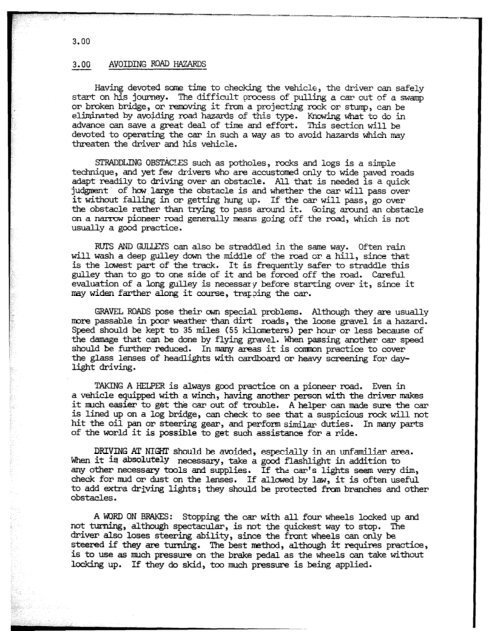'MIICROFICHE REFERENCE LIBRARY - Cd3wd.com
'MIICROFICHE REFERENCE LIBRARY - Cd3wd.com
'MIICROFICHE REFERENCE LIBRARY - Cd3wd.com
- No tags were found...
Create successful ePaper yourself
Turn your PDF publications into a flip-book with our unique Google optimized e-Paper software.
-3.003.00 AVOIDING ROAD HAZARDSHaving devoted same time to checking the vehicle, the driver can safelystart on h.i.s journey. The difficult process of pulling a car out of a swampor broken bridge, or removing it from a projecting rock or stump, can beeliminated by avoiding road hazards of this Qpe. Knowing what to do inadvance can save a great deal of time and effort. This section will bedevoted to operating the car in such a way as to avoid hazards which maythreaten the driver and his vehicle.STMDDLING OBSTACLES such as potholes, rocks and logs is a simpletechnique, and yet few drivers who are accustomed only to wide paved roadsadapt readily to driving over an obstacle. All that is needed is a quickjudgment' of hw.large the obstacle is and whether the car will pass overit without falling in or getting hung up. If the car will pass, go overthe obstacle rather than trying to pass around it. Going amund an obstacleon a narrow pioneer road generally means going off the road, which is notusuallyagoodpractice.RUTS AND GULUYS can also be straddled in the same way. Often rainwill wash a deep gulley down the middle of the road or a hill, since thatis the lwest part of the track. It is frequently safer to straddle thisgulley than to go to one side of it and be forced off the road. Carefulevaluation of a long gulley is necessary before starting over it, since itmaywidenfztheralong it course,tra@ngthe car.GR!WELROADSposetheirom special problems. Althoughtheyareusuallymorepassable inpoorweatherthandirt roads,theloose gravel is ahazard.Speed should be kept to 35 miles (55 kilometers) per hour or less because ofthe damage that can be done by flying gravel. When passing another car speedshould be further reduced. In many areas it is <strong>com</strong>mon practice to coverthe glass lenses ofheadlightswith cardboardorheavy screening for7daylightdriving.TAKING A HELPER is always good practice on a pioneer road. Even inavehicleequippedwithawinch,havinganotherpersonwiththedrivermakesit mxh easier to g&t the car out of trouble. A helper can made sure the caris lined up on a log bridge, can check to see that a suspicious rock will nothit the oil pan or steering gear, and perform similar duties. In many partsof the world it is possible to get such assistance for a ride.DRIYING AT NIGH should be avoided, especially in an unfamiliar area.When it 15 absolutely necessary, take a good flashlight in addition toany other necessary tools and supplies. If thd car's lights semnverydim,check for rmd or dust on the lenses. If allowed by law, it is often usefulto add extra driving lights; they should be protected fmn branches and otherobstacles.AWORDONBRAKES: Stopping the car with all four wheels locked up andnot turning, although spectacular, is not the quickest way to stop. Thedriver also loses steering ability, since the front wheels can only besteered if they are turning. The best method, although it requires practice,iS to use as much pressure on the brake pedal as the wheels can take withoutlocking up. If they do skid, too much pmasure is being applied.!,;‘.-..,’ _
















